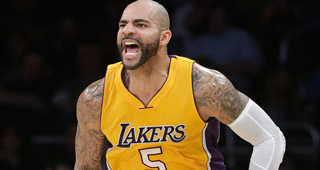Article VII, Section 12(f)(5) and Section 12(j) of the Collective Bargaining Agreement lay out most of the pertinent details on the amnesty provision.
Following the 2011 NBA lockout, the CBA was ratified to include a number of provisions including a return of the Amnesty provision which allowed each team the right to waive a player under contract prior to the 11-12 season.
How the Amnesty Provision Works
Using the amnesty provision takes that player’s salary off a team’s books but does not extinguish the team’s financial obligation to the player: This is the most important concept to grasp. If a team chooses to amnesty a player, said player will receive the entire guaranteed portion of that contract. The provision serves primarily as an accounting tool that removes that salary from both salary cap and luxury tax consideration. Interestingly, while those salaries do not count in those contexts, they still do add to a franchise’s payroll when calculating the salary floor. Regardless, the financial obligation to pay the contract still holds.
Amnestied players go through a modified waiver process: Typically, waived players go through a process where other franchises can pick them up by taking on their contracts in full. When a player is amnestied, teams can submit a full or a partial bid that comes in the form of a single number. Unless a team submits a full bid, the largest bid gets the player and that money gets taken off the waiving team’s financial obligation to the amnestied player.
For example, prior to the 14-15 season, the Bulls used their amnesty clause on Carlos Boozer. Boozer would later join the Lakers after they submitted the highest bid for him at $3.25 million. As a result, the Bulls were still liable for the remaining $16.8-$3.25= $13.55 million on Boozer’s deal.
Should a player go unclaimed, he becomes a free agent and can sign with any team interested in his services. The team is then liable for the full amount of the player’s contract. One amnesty-specific wrinkle: the bid amount only goes towards seasons with guaranteed money but any non-guaranteed seasons stay on the contract. This is how Brendan Haywood’s contract became valuable in the final non-guaranteed season.
Only players who had not changed teams from the start of the lockout and were under the same pre-CBA contract are eligible for the amnesty provision: This limitation helps explain some of the amnesty decisions because players like Baron Davis who had been recently traded to new teams before the lockout were eligible but Rashard Lewis was not once New Orleans acquired him in 2012.
Each franchise gets one amnesty during the life of the CBA: When combined with the last limitation, it makes sense that some teams had limited opportunities to use their amnesty. That said, it makes total sense to only give one bite at this apple.
Uses of the Amnesty Provision in the Current CBA
Twenty teams have used the amnesty provision under the current CBA, exactly two-thirds of the league. The teams who have used their contract have done so to rid exorbitant contracts from their salary cap, remove toxic personalities or remove injury prone players. For example, the Orlando Magic amnestied Gilbert Arenas shortly following the implementation of the amnesty clause. Arenas held an exorbitant contract and has generally been regarded as a toxic personality. However in the same year, the Portland Trail Blazers cut ties with Brandon Roy, who throughout his career was plagued with chronic knee injuries.
Amnestying a player does not always work in favor of the player’s original team. In 2011, the Knicks used their amnesty chip on Chauncey Billups in order to clear space to sign Tyson Chandler. Following this move, skeptics pointed to Amaré Stoudemire’s shaky knees, claiming the Knicks should have saved their amnesty for him. Over the following years, Stoudemire's knees and burdensome contract posed problems for the team. Another example of an imperfect amnesty choice would be the Warriors using it on Charlie Bell’s expiring contract instead of saving it for either Andris Biedrins (who they later gave up a first round pick to unload) or David Lee in a later season.
RealGM has a full list of how teams used the amnesty provision under the current Collective Bargaining Agreement.
Conclusion
A popular and frequently used piece of both of the last two CBA’s, the amnesty provision has outlived its usefulness in the current agreement. It appears likely that it will be a part of the next Collective Bargaining Agreement (likely coming in 2017) in some form.



